Contents
The structure of the bee is considered so unique that there is a special science in biology that studies the external and internal structure of honey bees – apiology. In Europe, the term sounds like apidology and includes research on all types of bees.
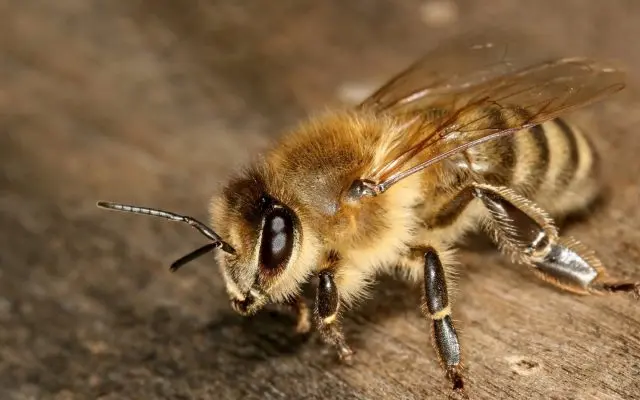
The external structure of the bee
Bees, like other types of insects, lack a skeleton. Its role is able to perform a complex skin, which contains chitin.
The coloring of the bee and its body structure makes it possible to distinguish the insect from all other species. The body has a clear distribution and consists of three sections:
- head;
- chest;
- abdomen.
Each of these departments performs a certain significance in the life of an insect and includes a certain set of organs. On the sides of the head are two compound eyes, between which are three simple ones. Each eye perceives a certain part of the picture, and in the aggregate, all this is converted into a single image. Scientists call this type of vision mosaic. The eye consists of a lens, and small hairs are located around it.
With the help of compound eyes, insects can see objects that are far away, thanks to which they orient themselves during a flight in space. Simple eyes allow the formation of an image that is in close proximity, which allows the insect to collect pollen.
If we consider the oral apparatus of the bee, we can see that the proboscis is located in the lower part of the head, which includes the lower jaw and lower lip. The length of the proboscis can vary depending on the type of individual and varies from 5,6 to 7,3 mm. Since the internal organs are located in the abdomen, this part is the largest and heaviest.
You can see the structure of the honey bee in the photo below.
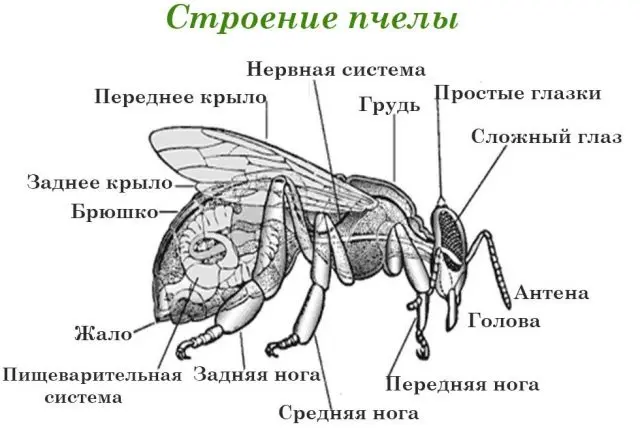
How many eyes does a bee have and how does it see the world around it?
In total, the insect has five eyes. Of these, 3 are simple, they are located on the frontal part of the bee’s head, the rest are complex, located on the sides. Simple eyes differ little from each other, but complex ones have significant differences in size and number of facets, for example:
- the queen of the hive has compound eyes located on the sides, the number of facets reaches 4 thousand pieces;
- the eyes of a worker bee are oval in shape, while they are much smaller and number 5 thousand pieces. facets;
- more complex eyes in drones. As a rule, they are quite large and are connected in the frontal part; the number of cells can exceed 10 thousand pieces.
Due to the special structure of the eyes, insects can see three-dimensional objects, while the shape may differ from what a person sees. For example, insects perceive geometric shapes very poorly. They see color forms much more clearly. Individuals show the greatest interest in objects that move. In addition, bees can read light vibrations and use this for orientation in space.
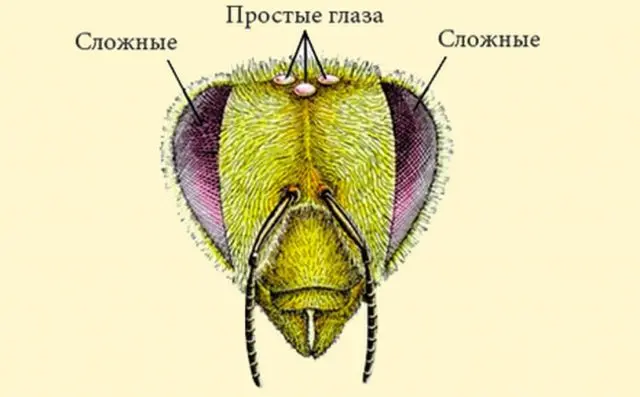
How many wings does a bee have
In total, the bee has four wings, while the two front wings completely cover the pair of rear ones. During the flight, they are connected in one plane.
Individuals set the wings in motion with the help of the pectoral muscles. It should be noted that up to 450 wing flaps can be carried out in one second. In a minute, an insect can fly 1 km, but an individual carrying nectar flies much more slowly. That is, a bee heading for honey flies faster than an individual returning with prey.
In search of nectar, insects can fly away from the apiary for a maximum of 11 km, but most often they fly around at a distance of no more than two km from the hives. This is due to the fact that the farther the insect flies, the less nectar will be brought home.
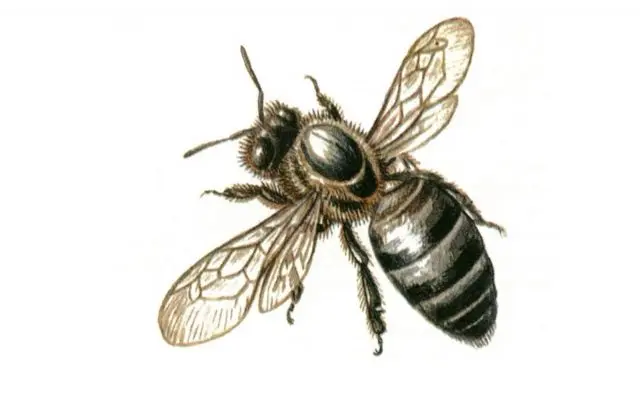
How many legs does a bee have
If we consider the structure of a bee in the picture, then it is worth noting that it has 3 pairs of legs, and they all differ from each other. The middle pair is the least specialized in its structure. Each foot consists of the following parts:
- basin;
- swivel;
- hip;
- shin;
- tarsus with 5 segments.
In addition, the legs have claws that allow insects to cling to the surface during movement. The front paws in appearance resemble hands, they are quite powerful. Insects use them to perform various types of work. The hind limbs are equipped with special devices called baskets.
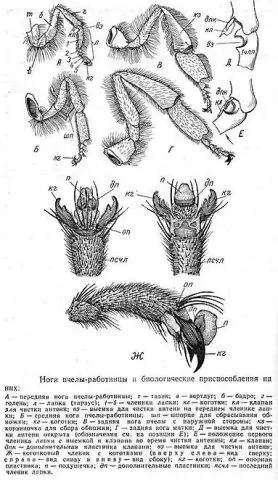
Anatomy of a bee
A feature of the internal structure of the bee is the presence of organs with the help of which honey is produced. This applies to the digestive system of the insect, namely, the presence of special organs – the honey goiter and the subpharyngeal gland. In the goiter, insects store nectar, and with the help of enzymes, the process of converting nectar into honey is carried out.
Thanks to the developed muscular and nervous system, insects fly fast enough, build honeycombs, extract and process nectar. Such activity is possible only due to the continuous respiratory process.
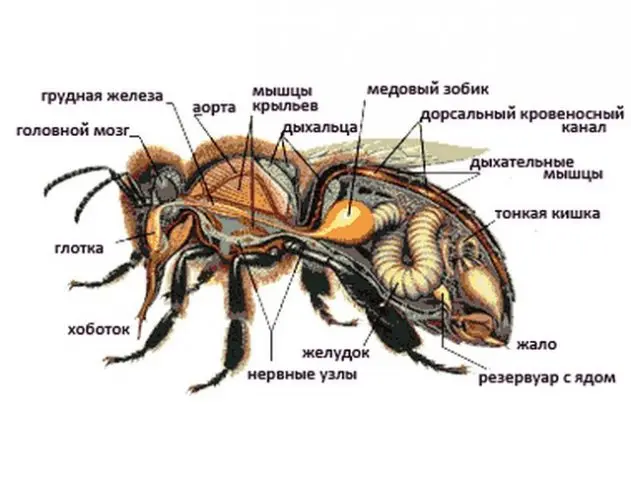
Does a bee have a heart
It’s hard to believe, but bees have a heart. In appearance, the heart of an insect resembles a long tube, which is located in the upper part of the body and runs through the entire back to the head. Much thinner tubes stretch through the chest of the bee, they are called aorta. Hemolymph flows from the aorta into the head cavity of the insect. The tube is securely fixed by muscle fibers to the back of the insect and has 5 chambers that communicate with each other. With the help of such chambers, hemolymph is passed through, while the substance moves only in one direction – from the abdomen to the head.
The emitted sound deserves special attention, which may differ in pitch and timbre. Each family emits an individual buzz, depending on the physiological state. It is thanks to the sounds made that beekeepers determine and control the state of individuals. Thanks to the buzzing tone, experienced beekeepers can understand the following:
- insects are cold;
- subsistence is over;
- the family plans to swarm;
- the hive queen is present;
- The hive queen is either dead or missing.
In addition, one can understand how the family relates to the new uterus if the replacement of the old or deceased queen was carried out.

How many stomachs does a bee have
When conducting regular studies of the structure of the body of an insect, the following amazing facts were revealed:
- the insect has 2 stomachs, one is for digestion, and the second for honey;
- the stomach intended for honey does not produce digestive juices.
An enzyme is produced in the stomach, due to which the nectar is split into honey and fructose. Under the action of the enzyme, the nectar is completely broken down, the insects begin to secrete pure nectar into cells designed to store honey.
Insects get honey from nectar, which, in turn, is almost 80% water and sugar. With the help of a proboscis, the bees suck out and lay it in the stomach, intended exclusively for honey.
To completely fill the stomach with insects, it is necessary to fly from 100 to 1500 flowers.

How bees breathe
Considering the respiratory system of bees, it can be noted that throughout the body of the insect there is a network of tracheae of different lengths. Air sacs are located along the body, which are used as a reservoir for oxygen. These cavities are interconnected by special transverse trunks.
In total, the bee has nine pairs of spiracles:
- three pairs are located in the chest area;
- six are in the abdomen.
Air enters the body of the insect through spiracles, which are located on the abdomen, and through the thoracic spiracles it exits back. On the walls of the spiracles there are a large number of hairs that perform a protective function and prevent dust from entering.
In addition, the spiracles have a device that allows you to close the lumen of the trachea. Air moves through the air sacs and trachea. At the moment when the bee’s abdomen is expanded, air begins to flow from the spiracles into the trachea and air sacs. When the abdomen contracts, air is released. After that, air enters the trachea from the air sacs and is carried throughout the body of the individual. When all the oxygen is taken up by the cells, carbon dioxide is released.
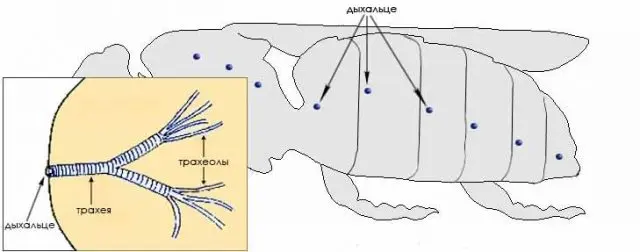
Conclusion
The structure of a bee is of interest to many, and this is not surprising, because hardworking insects can only be admired. Bees lead an active lifestyle – they fly quite quickly, collect nectar, and then transform it into honey. The study of bees continues to this day, as a result of which you can constantly learn more and more new facts about them.









